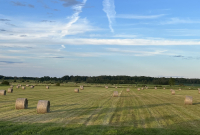Support strong Canadian climate journalism for 2025
B.C. is examining long-standing roadblocks to intercity transportation for rural communities on Vancouver Island and other underserved areas in the province.
The province is spending $2.5 million on in-person and virtual community consultations and online surveys to study passenger transportation gaps faced by rural and remote areas on Vancouver Island and parts of the coastal mainland, as well as B.C.’s north and southern Interior.
The consultations are being led by Coastal Economic Trust and Vancouver Island Economic Alliance (VIEA) and will take place this month for most communities on Vancouver Island, the Central and Sunshine coasts and surrounding small islands. Greater Victoria and existing public transit services in individual communities aren’t being evaluated.
Tahsis, a small community on Vancouver Island’s remote northwest coast, has been working for years to establish a community bus or shuttle to the nearest city of Campbell River, said Mayor Martin Davis.
“There’s quite a demand here for it,” he said.
In 2019, a community survey showed an affordable bus service to the city was the top issue for the remote village’s 500 residents — half of whom are retired and more than 44 per cent older than 60, Davis said.
Residents need to make regular runs along the 150-kilometre stretch of gravel and paved road to Campbell River for health care, groceries and supplies, and various services.

The remote road out of the village is steep and winding, with sharp corners over a mountain pass.
Not all residents have vehicles, and many older folks don’t feel safe driving the road, particularly in winter, Davis said.
People try to catch rides with other residents, but if they can’t, it can mean missing important appointments.
“And we have young people that don't have vehicles and they're always looking for rides in and out.”
The study isn’t only looking at bus service, said Julie Sperber, CEO of VIEA, noting a number of coastal or island communities need or use other forms of transport like ferries, water taxis and even floatplanes to get around.
Looking at connection gaps along routes that include ferries and other means of transport, like transit, is one of the goals, Sperber said. With improvements, the pressure on BC Ferries could be reduced, she added.
“Often we are a car-dominated region, so that limits people's accessibility to travel either for work or appointments or services that are key for economic and social well-being,” she said.
The study may inform provincial investment in transportation infrastructure that results in fewer cars on the road, she added.
“It would make a huge difference in the region in terms of climate action and mitigation,” Sperber said.
Along with funding the study, the province is setting up a micro-funding program with grants up to $15,000 to help finance transportation priorities or projects raised by communities during the surveys, she said.
The survey data will help inform the province’s next steps for developing options for transportation solutions in rural communities, the Ministry of Transportation said in an email. However, no concrete details or timelines for action were provided.
The province is working on a Clean Transportation Action Plan to drive down greenhouse gas emissions and boost clean transportation options, which the ministry said will be released sometime this year.
One of the goals of the action plan is to increase the share of trips made by walking, cycling and transit to 30 per cent by 2030.
But the ministry has not clarified if a provincewide clean, affordable public transport system that meets rural communities’ needs for intercity transport is a pillar of that plan.
Two separate interview requests to Transportation Minister Rob Fleming by Canada’s National Observer about intercity transportation gaps in rural communities have gone unanswered since March.
The province set up the BC Bus North intercity network after Greyhound withdrew services for the northern mainland in 2018, particularly along Highway 16, dubbed the Highway of Tears after at least 18 women, most Indigenous, were murdered or went missing.
But the government-funded BC Bus North service and associated community shuttle network don’t extend to rural or isolated First Nations communities in the southern parts of the province or on Vancouver Island.
The ministry didn’t reply to questions about how the province determines where it provides subsidized regional transport and why the system is limited to northern B.C.
The province also announced $5 million in funding to continue operating BC Bus North and the shuttle program until 2026-27, along with another $250,000 to set up a new reservation system.
Tiny communities like Tahsis don’t have the money to set up shuttle or bus services on their own, Davis said.
“Trying to make this happen, we realized the costs are too high and there’s strength in numbers.”
Now, Strathcona Regional District (SRD) is evaluating the possibility of a regional shuttle to connect other remote municipalities, such as Gold River, Fair Harbour, Zeballos, Woss and Sayward and the First Nations communities of Kyuquot, Yuqot, and Tsaxana with Campbell River, Davis said.
But there’s no guarantee it will happen, especially given opposition by a number of regional directors including Campbell River Mayor Kermit Dahl and Area A director Gerald Whalley.
Davis figures the odds of the SRD board backing any proposed shuttle service is 50/50.
“I realize governments can't subsidize everything, but I think it would be worthwhile for them to put something in because I think it would enhance their economic viability down the road,” he said.
Davis hopes the province will also subsidize a shuttle network to provide western island communities, some only accessible by water, or without a grocery store or many medical services, a connection to Campbell River.
The province shouldn’t duplicate work the SRD has already done and paid for, Davis said, but he’s hopeful the transportation surveys spark commitment by the province to provide affordable connectivity for rural communities.
“The fact they're putting money out there to do these regional transit studies shows that they're interested and they see the need.”
Rochelle Baker / Local Journalism Initiative / Canada's National Observer






Comments